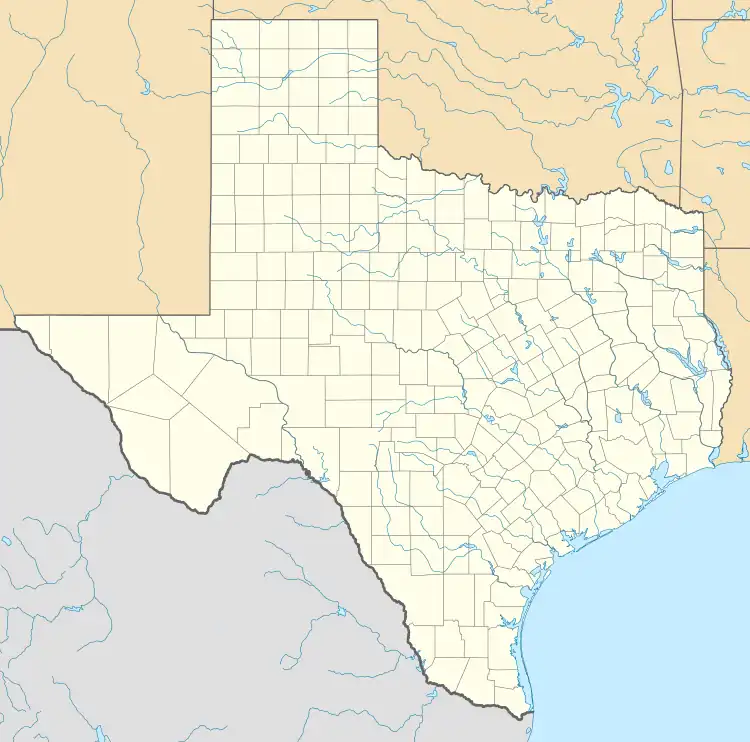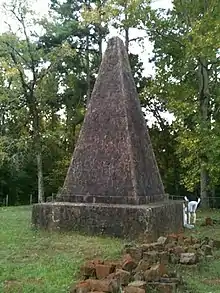| Killough Massacre | |
|---|---|
| Location | Larissa, Cherokee County, Texas [1] |
| Coordinates | 32°3′17.18″N 95°20′35.33″W / 32.0547722°N 95.3431472°W |
| Date | October 5, 1838 (UTC-6) |
Attack type | Raid on a frontier settlement |
| Deaths | 18 either killed or carried away |
| Victim | Killough, Wood, and Williams families |
| Perpetrators | Cherokee |
| Defenders | 8 escaped on horseback |
| Motive | Rage over abrogated treaty |

The Killough massacre is believed to have been both the largest and last Native American attack on white settlers in East Texas. The massacre took place on October 5, 1838, near Larissa, Texas, in the northwestern part of Cherokee County. There were eighteen victims, including Isaac Killough, Sr., and his extended family (viz. the families of four sons and two daughters). They had immigrated to the Republic of Texas from Talladega County, Alabama, in 1837.[2][3]
Context
Apparently unaware that the land made available to them was hotly disputed by the Cherokee Indians who lived in the area, Isaac Killough and his homesteaders began clearing land for crops and building homes. Only a year earlier, however, the area surrounding their settlement had been set aside for the Cherokee under a treaty negotiated and signed by Sam Houston and John Forbes. When the Republic of Texas Senate refused to ratify the treaty and then, in December 1838, formally nullified it, the Cherokee, who already thought they had conceded enough, became homicidal.[4]
The influx of Anglo settlers into lands thought to have been theirs increased Cherokee resentment, and as there was also residual bitterness among some Hispanics still loyal to Mexico, the atmosphere in the region became tense in early 1838. By the summer of that year, there were rumblings of coming insurrection from either or both of those factions, and evidence existed for collusion between them.[5]
Fearing this growing unrest, Killough with his relatives and friends fled to Nacogdoches for refuge. On condition they would leave the area after doing so, the Cherokee leaders agreed to their safe passage if they would return simply to harvest their crops. They did so. But on October 5, 1838, a band of Cherokee who had not been party to the agreement attacked the settlement. Most of the Killough group—a total of eighteen—were killed or abducted as they worked their fields. Those who survived fled for a time to Lacy's Fort on the San Antonio Road, just west of present-day Alto, Texas.[6]

According to Tyler, Texas, newspaperman Charles Kilpatrick, several of the men walked into an ambush and the Native Americans then:
...shot down Allen and Samuel, George Wood, and Isaac Jr., then swept uphill into the little settlement. Isaac Sr. fell in his yard and Barakias Williams was shot before the eyes of his womenfolk.
Warriors seized two 17-year-old girls, Elizabeth Killough and Elizabeth Williams, Mrs. Allen Killough, Mrs. George Wood and all the small children. They were carried screaming into the forest, never to be seen again.
Nathaniel Killough and his wife escaped into a canebreak, as did Mrs. Samuel Killough, Mrs. Isaac Killough Sr., Mrs. Isaac Killough Jr., and the baby, William. Three perilous days later they staggered into Fort Lacy, near Alto.[7]
A stone obelisk commemorating the event was erected by the Work Progress Administration in the 1930s, and a historical marker was dedicated in 1965.
See also
References
- ↑ Larissa, Texas - TSHA Online |
- ↑ Killough Massacre - TSHA Online |
- ↑ Killough Massacre: 7 miles northwest of Jacksonville on US 69, north to FM 855 then southeast on CR 3405 to monument site on CR 3411: Texas marker #6975 |
- ↑ Handbook of Texas Online. "Cherokee War". Retrieved December 7, 2012.
on February 23, 1836, a treaty made by Sam Houston and John Forbes, who represented the provisional government, gave title to the lands between the Angelina and Sabine rivers and northwest of the Old San Antonio Road to the Cherokees and their associated bands. The treaty was tabled by the Texas Senate on December 29, 1836, and was declared null and void by that body on December 16, 1837, despite Houston's insistence that it be ratified.
- ↑ Herring, Rebecca J. ""Cordova Rebellion," Handbook of Texas Online". Retrieved December 7, 2012.
The capture of two Mexican agents after the rebellion produced new evidence pointing to an extensive Indian and Mexican conspiracy against Texas. On about August 20, 1838, Julián Pedro Miracle was killed near the Red River. On his body were found a diary and papers that indicated the existence of an official project of the Mexican government to incite East Texas Indians against the Republic of Texas.
- ↑ "Killough Massacre, from Ghosts of East Texas and the Pineywoods by Mitchel Whitington".
- ↑ Kilpatrick, Charles (8 June 1949). "Texas' Last Indian Battle". Tyler Morning Telegraph. Tyler. Texas.
External links
- Killough Massacre Burial Site Cemetery
- Killough Reunion Association
- Remembering the Killough Massacre Archived 2011-09-28 at the Wayback Machine, Tyler Morning Telegraph, Kenneth Dean – writer, June 21, 2010.